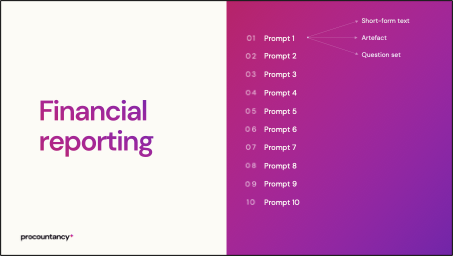Accounting courses of the future
Posted by Hugh Martin. Last updated: September 12, 2024
Hugh Martin, founder of Procountancy, provides a step-by-step guide for guiding students to use AI prompts in accounting education.

When you think about accounting courses, what comes to mind? For me, it’s gigantic textbooks, long-running lectures, lengthy examples, and several disparate resources like practice questions and summary notes.
Even in the modern age of online or blended delivery models, courses take a one-size-fits-all approach, and the material delivered is effectively the same regardless of student ability or needs.
Technology developments mean that new delivery models are possible. The exact model that academic and commercial institutions will rally behind is unclear, but here’s one to ponder.
The AI prompt-based model
Here’s an introduction to a prompt-based model: an online and on-demand tool for accountancy or other courses with similar subject matter. It provides students with a one-page PDF covering everything they need to know about a topic.
It sounds a bit weird, but let’s look at it in depth.
For illustration, let’s say the topic is financial reporting and there are ten key topic areas. The PDF does not contain content but ten prompt groups that each student enters sequentially into a generative Artificial Intelligence (AI) tool.
The technology used here effectively allows you to train an AI tutor using existing course content. This type of technology has use cases in customer service but can equally be used in education.
Here’s what this PDF might look like (with prompts filled in, of course):

The prompt group will produce AI-generated information in sequence:
(1) Short-form text
The AI is prompted to show formatted, easy-to-understand, text-based information on the topic area. For example, information summarising the basics of the IFRS Conceptual Framework for Financial Reporting and how they might be applied in a practical scenario.
(2) Artefact
The AI is prompted to provide an interactive display illustrating a key learning outcome. This is where students “do” an activity. It could be something like a game in which the correct costs or rules must be placed in the correct bins before a timer runs out.
(3) Question set
The AI is prompted to generate multiple-choice questions based on the text-based information generated earlier and possibly even a discussion-based question based on the same information.
(4) Solutions
Solutions can be generated once the questions have been answered.
A practical demonstration
To demonstrate, let’s look at an example prompt group. To avoid cognitive overload, students should do this in four parts.
- Part 1 – Short-form text
- Please explain the IFRS Conceptual Framework for Financial Reporting, including an evaluation of the necessity of conceptual frameworks for financial reporting purposes.
- Part 2 – Artefact
- Create a drag-and-drop game to help players understand the fundamental and enhancing characteristics of useful financial information.
- Part 3 – Question set
- Draft twenty multiple-choice questions that test everything presented so far. Ensure that four options are available for each question, with only one correct option.
- Part 4 – Solutions
- Reveal the correct answers and solutions for each of the questions presented above.
In this situation, the student has the option to further investigate the information received, typically after reviewing the output of Part 1 — Short-form text.
So, for example:
- Part 1 – Short text
- In which countries is it legally required to apply the IFRS Conceptual Framework for Financial Reporting?
- Provide some examples of faithful representation using real-world companies; I’m not sure I understand this concept.
Benefits and challenges
The main benefit of this approach is that it can be individualistic. Students can use the AI tool to interrogate and inquire about the information presented based on their own curiosity and understanding. By carrying out the test set prompts at the end, questions can cover the areas of interrogation that will be individual to students.
This approach also reduces the risk of information overload and overwhelm — a real issue when dealing with content-heavy course areas like financial reporting and taxation.
Finally, this approach takes a realistic view of AI tools and acknowledges that students need to know how to use them for their future careers.
AI is generally seen as a threat to our existing jobs and ways of doing things. This model doesn’t necessarily make roles redundant; it just shifts the role played by staff within an institute or education provider.
This model gives the institute a role in that it must:
- Train the AI model,
- Write and structure the prompts, and
- Ensure that students are working their way through the course.
The tricky part of this model is assessment. However, regardless of the delivery model chosen for these types of courses, that will need radical change. I’ll get to that one another day.
Part of the Teaching tips series
© AccountingCafe.org
About Hugh Martin
Hugh Martin is the owner of Procountancy, a test prep business that focuses on preparing students for their global professional accountancy exams.
He is an experienced CIMA Case Study tutor and worked as the Director of Content for a leading accountancy tuition business. He is a former CIMA prizewinner, and countless prizewinners have used his materials over the last three years.




